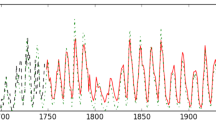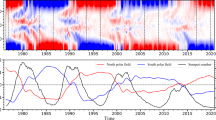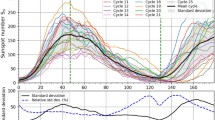Abstract
Predicting the behavior of a solar cycle after it is well underway (2–3 years after minimum) can be done with a fair degree of skill using auto-regression and curve fitting techniques that don’t require any knowledge of the physics involved. Predicting the amplitude of a solar cycle near, or before, the time of solar cycle minimum can be done using precursors such as geomagnetic activity and polar fields that do have some connection to the physics but the connections are uncertain and the precursors provide less reliable forecasts. Predictions for the amplitude of cycle 24 using these precursor techniques give drastically different values. Recently, dynamo models have been used directly with assimilated data to predict the amplitude of sunspot cycle 24 but have also given significantly different predictions. While others have questioned both the predictability of the solar cycle and the ability of current dynamo models to provide predictions, it is clear that cycle 24 will help to discriminate between some opposing dynamo models.
Similar content being viewed by others
References
H.S. Ahluwalia, The predicted size of cycle 23 based on the inferred three-cycle quasi-periodicity of the planetary index Ap. J. Geophys. Res. 103(A6), 12,103–12,109 (1998)
H.W. Babcock, The topology of the Sun’s magnetic field and the 22-year cycle. Astrophys. J. 133, 572–587 (1961)
G.M. Brown, What determines sunspot maximum? Mon. Not. Roy. Astron. Soc. 174, 185–190 (1976)
P.J. Bushby, S.T. Tobias, On predicting the solar cycle using mean-field models. Astrophys. J. 661, 1289–1296 (2007)
R. Cameron, M. Schüssler, Solar cycle prediction using precursors and flux transport models. Astrophys. J. 659, 801–811 (2007)
A.R. Choudhuri, P. Chatterjee, J. Jiang, Predicting solar cycle 24 with a solar dynamo model. Phys. Rev. Lett. 98, 131103 (2007)
M. Dikpati, P. Charbonneau, A Babcock-Leighton flux transport dynamo with solar-like differential rotation. Astrophys. J. 518, 508–520 (1999)
M. Dikpati, G. de Toma, P.A. Gilman, Predicting the strength of solar cycle 24 using a flux-transport dynamo-based tool. Geophys. Res. Lett. 33, L05102 (2006)
M. Dikpati, G. de Toma, P.A. Gilman, Polar flux, cross-equatorial flux, and dynamo generated tachocline toroidal flux as predictors of solar cycles. Astrophys. J. 675, 920–930 (2008)
W. Elling, H. Schwentek, Fitting the sunspot cycles 10-21 by a modified F-distribution density function. Sol. Phys. 137, 155–165 (1992)
J. Feynman, Geomagnetic and solar wind cycles, 1900–1975. J. Geophys. Res. 87(A8), 6153–6162 (1982)
W. Gleissberg, A long-periodic fluctuation of the Sun-spot numbers. The Observatory 62, 158–159 (1939)
M.N. Gnevyshev, A.I. Ohl, On the 22-year solar activity cycle. Astron. Z. 25, 18–20 (1948)
K.L. Harvey, O.R. White, What is solar cycle minimum? J. Geophys. Res. 104(A9), 19,759–19,764 (1999)
D.H. Hathaway, Doppler measurements of the Sun’s meridional flow. Astrophys. J. 460, 1027–1033 (1996)
D.H. Hathaway, R.M. Wilson, E.J. Reichmann, The shape of the solar cycle. Sol. Phys. 151, 177–190 (1994)
D.H. Hathaway, R.M. Wilson, Geomagnetic activity indicates large amplitude for sunspot cycle 24. Geophys. Res. Lett. 33, L18101 (2006)
D.H. Hathaway, R.M. Wilson, E.J. Reichmann, A synthesis of solar cycle prediction techniques. J. Geophys. Res. 104(A10), 22,375—22,388 (1999)
J. Javaraiah, North-south asymmetry in solar activity: predicting the amplitude of the next solar cycle. Mon. Not. R. Astron. Soc. 377, L34–L38 (2007)
J.A. McKinnon, ‘Sunspot numbers 1610–1985 based on sunspot-activity in the years 1610–1960, Rep. UAG-95 World Data Center A for Sol.-Terr. Phys., Boulder, Colo. (1987), 105 pp
A.G. McNish, J.V. Lincoln, Prediction of sunspot numbers. Trans. AGU 30, 673–685 (1949)
A.I. Ohl, Forecast of sunspot maximum number of cycle 20. Solice Danie 9, 84 (1966)
K.H. Schatten, S. Sofia, Forecast of an exceptionally large even-numbered solar cycle. Geophys. Res. Lett. 14(6), 632–635 (1987)
K.H. Schatten, P.H. Scherrer, L. Svalgaard, J.M. Wilcox, Using dynamo theory to predict the sunspot number during solar cycle 21. Geophys. Res. Lett. 5(5), 411–414 (1978)
S.K. Solanki, N.A. Krivova, M. Schüssler, M. Fligge, Search for a relationship between solar cycle amplitude and length. Astron. Astrophys. 396, 1029–1035 (2002)
J.Q. Stewart, H.A.A. Panofsky, The mathematical characteristics of sunspot variations. Astrophys. J. 88, 385–407 (1938)
L. Svalgaard, E.W. Cliver, Y. Kamide, Sunspot cycle 24: Smallest cycle in 100 years? Geophys. Res. Lett. 32, L01104 (2005)
R.J. Thompson, A technique for predicting the amplitude of the solar cycle. Sol. Phys. 148, 383–388 (1993)
S. Tobias, D. Hughes, N. Weiss, Unpredictable Sun leaves researchers in the dark. Nature 442, 26 (2006)
M. Waldmeier, Neue eigenschaften der sonnenfleckenkurve. Astron. Mitt. Zurich 14(133), 105–130 (1935)
M. Waldmeier, The sunspot-activity in the years 1610–1960, Zürich Schulthess, Zürich (1961), 171 pp
R.M. Wilson, D.H. Hathaway, E.J. Reichmann, An estimate for the size of cycle 23 based on near minimum conditions. J. Geophys. Res. 103(A4), 6595–6603 (1998)
R. Wolf, Nachrichten von der Sternwarte in Bern. Sonnenflecken Beobachtungen in der zweiten Hafte des Jahres 1851. Naturf. Gesell. Bern Mitt. 229/230, 41–48 (1852)
R. Wolf, Abstract of his latest results. Mon. Not. R. Astron. Soc. 21, 77–78 (1861)
A.R. Yeates, D. Nandy, D.H. Mackay, Exploring the physical basis of solar cycle predictions: Flux transport dynamics and persistence of memory in advection- vs. diffusion-dominated solar convection zones. Astrophys. J. 673, 544–556 (2008)
Author information
Authors and Affiliations
Corresponding author
Rights and permissions
About this article
Cite this article
Hathaway, D.H. Solar Cycle Forecasting. Space Sci Rev 144, 401–412 (2009). https://doi.org/10.1007/s11214-008-9430-4
Received:
Accepted:
Published:
Issue Date:
DOI: https://doi.org/10.1007/s11214-008-9430-4




